Analysis of Carbon Storage and Its Contributing Factors—A Case Study in the Loess Plateau (China)
Abstract
1. Introduction
2. Materials and Methods
2.1. Study Area
2.2. Data Sources
2.2.1. LUCC Data
2.2.2. NDVI
2.2.3. Digital Elevation Model (DEM)
2.2.4. Slope
2.2.5. Precision-Test Data
2.2.6. Carbon Density Parameters of 2000
2.3. Research Methods
2.4. Precision Testing and Sample Analysis
3. Results
3.1. Carbon Storage Patterns
3.2. The Contribution of Changes in Land Use Type to Carbon Storage
3.3. The Contribution of Carbon Density to Carbon Storage
3.4. The Relationships between Carbon Storage and Geographical Factors
4. Discussion
5. Conclusions
Author Contributions
Acknowledgments
Conflicts of Interest
References
- Jorgensen, L. Newsletter of the Global Land Project International Project Office GLP News GLP Nodal Offices Newsletter of the Global Land Project International Project Office G Pn New E WS; GLP: Taipei, Taiwan, 2010. [Google Scholar]
- Foley, J.A.; DeFries, R.; Asner, G.P.; Barford, C.; Bonan, G.; Carpenter, S.R.; Chapin, F.S.; Coe, M.T.; Daily, G.C.; Gibbs, H.K.; et al. Global Consequences of Land Use. Science 2005, 309, 570–574. [Google Scholar] [CrossRef] [PubMed]
- Rindfuss, R.R.; Walsh, S.J.; Turner, B.L.; Fox, J.; Mishra, V. Developing a science of land change: Challenges and methodological issues. Proc. Natl. Acad. Sci. USA 2004, 101, 13976–13981. [Google Scholar] [CrossRef] [PubMed]
- Zhao, S.Q.; Liu, S.; Li, Z.; Sohl, T.L. Ignoring detailed fast-changing dynamics of land use overestimates regional terrestrial carbon sequestration. Biogeosciences 2009, 6, 1647–1654. [Google Scholar] [CrossRef]
- Bennett, M.T. China’s sloping land conversion program: Institutional innovation or business as usual? Ecol. Econ. 2008, 65, 699–711. [Google Scholar] [CrossRef]
- Food and Agriculture Organization (FAO). Global Forest Resources Assessment 2000 Main Report; FAO Forestry Paper; FAO: Rome, Italy, 2010. [Google Scholar]
- Breidenich, C.; Magraw, D.; Rowley, A.; Rubin, J.W. The Kyoto Protocol to the United Nations Framework Convention on Climate Change. Am. J. Int. Law 1998, 92, 315–331. [Google Scholar] [CrossRef]
- Bohn, H.L. Estimate of Organic Carbon in World Soils. Soil Sci. Soc. Am. J. 1982, 40, 468–470. [Google Scholar] [CrossRef]
- Eswaran, H.; Berg, E.V.D.; Reich, P. Organic Carbon in Soils of the World. Soil Sci. Soc. Am. J. 1993, 90, 269–273. [Google Scholar] [CrossRef]
- Feng, J.; Hao, Y.; Qiguo, Z. Soil organic carbon and its influencing factors. Soils 2000, 32, 11–17. [Google Scholar]
- Post, W.M.; Emanuel, W.R.; Zinke, P.J.; Stangenberger, A.G. Soil carbon pools and world life zones. Nature 1982, 298, 156–159. [Google Scholar] [CrossRef]
- Qing, T.; Yong, X.; Yi, L. Spatial difference of land use change in Loess Plateau region. J. Arid Land Resour. Environ. 2010, 24, 15–21. [Google Scholar]
- Ai, Z.; Chen, Y.; Cao, Y. Storage and allocation of carbon and nitrogen in Robinia pseudoacacia plantation at different ages in the loess hilly region, China. Chin. J. Appl. Ecol. 2014, 25, 333–341. [Google Scholar]
- Li, J.; Wang, X.; Shao, M.; Zhao, Y.; Li, X. Simulation of biomass and soil desiccation of Robinia pseudoacacia forestlands on semi-arid and semi-humid regions of China’s Loess Plateau. Chin. J. Plant Ecol. 2010, 34, 330–339. [Google Scholar]
- Chen, X.; Ma, Q.; Kang, F.; Cao, W.; Zhang, G.; Chen, Z. Studies on the Biomass and Productivity of Typical Shrubs in Taiyue Mountain, Shanxi Province. For. Res. 2002, 15, 304–309. [Google Scholar]
- Zhang, B.; Chen, C. Biomass and Production of Robinia Pseudoacacia Plantation in Hongxing Tree Farm of Changwu Country, Shaanxi Province. Shaanxi For. Sci. Technol. 1992, 3, 13–17. [Google Scholar]
- Ruesch, A.; Gibbs, H.K. New IPCC Tier-1 Global Biomass Carbon Map for the year 2000 [DB/OL]; The Carbon Dioxide Information Analysis Center, Oak Ridge National Laboratory: Oak Ridge, TN, USA, 2008. [Google Scholar]
- Carré, F.; Hiederer, R.; Blujdea, V.; Koeble, R. Background Guide for the Calculation of Land Carbon Stocks in the Biofuels Sustainability Scheme Drawing on the 2006 IPCC Guidelines for National Greenhouse Gas Inventories; Joint Research Center, European Commission: Luxembourg, 2010. [Google Scholar]
- Paustian, K.; Ravindranath, N.H.; Amstel, A.V. 2006 IPCC Guidelines for National Greenhouse Gas Inventories; Agriculture, Forestry and Other Land Use; IPCC: Geneva, Switzerland, 2006; Volume 4. [Google Scholar]
- Sharp, R.; Tallis, H.; Ricketts, T.; Guerry, A.; Wood, S.; Chaplin-Kramer, R.; Nelson, E.; Ennaanay, D.; Wolny, S.; Olwero, N.; et al. InVEST 3.1.2 User’s Guide; The Natural Capital Project: Stanford, CA, USA, 2015. [Google Scholar]
- Li, J.; Ma, Y.L.; Luo, J.; Li, H.; Luo, Z.B. Nutrients and Biomass of Different-Aged Robinia Pseudoacacia Plantations in the Loess Hilly Region. Available online: http://www.cqvip.com/qk/97059x/201303/45949088.html (accessed on 14 May 2018).
- Parton, W.J.; Schimel, D.S.; Cole, C.V.; Ojima, D.S. Analysis of Factors Controlling Soil Organic Matter Levels in Great Plains Grasslands1. Soil Sci. Soc. Am. J. 1987, 51, 1173–1179. [Google Scholar] [CrossRef]
- Oren, R.; Ellsworth, D.S.; Johnsen, K.H.; Phillips, N.; Ewers, B.E.; Maier, C.; Schäfer, K.V.; McCarthy, H.; Hendrey, G.; McNulty, S.G.; et al. Soil fertility limits carbon sequestration by forest ecosystems in a CO2-enriched atmosphere. Nature 2001, 411, 469–472. [Google Scholar] [CrossRef] [PubMed]
- Chen, C.; Peng, H. Standing Crops and Productivity of the Major Forest-types at the Huoditang Forest Region of the Qingling Mountains. J. Northwest For. Coll. 1996, 11, 92–102. [Google Scholar]
- Chen, Q.; Shen, C.; Yi, W.; Peng, S.; Li, Z. Progresses in soil carbon cycle researches. Adv. Earth Sci. 1998, 13, 555–563. [Google Scholar]
- Huang, G.S.; Xia, C. MODIS-Based Estimation of Forest Biomass in Northeast China. For. Resour. Manag. 2005, 4, 40–44. [Google Scholar]
- Mittelbach, G.G.; Steiner, C.F.; Scheiner, S.M.; Gross, K.L.; Reynolds, H.L.; Waide, R.B.; Willig, M.R.; Dodson, S.I.; Gough, L. What is the observed relationshio between species richness and productivity. Ecology 2001, 82, 2381–2396. [Google Scholar] [CrossRef]
- Mccarthy, M.C.; Enquist, B.J. Consistency between an allometric approach and optimal partitioning theory in global patterns of plant biomass allocation. Funct. Ecol. 2007, 21, 713–720. [Google Scholar] [CrossRef]
- Sun, J.; Cheng, G.W.; Li, W.P. Meta-analysis of relationships between environmental factors and aboveground biomass in the alpine grassland on the Tibetan Plateau. Biogeosciences 2013, 10, 1707–1715. [Google Scholar] [CrossRef]
- Yan, L.; Zhou, G.; Zhang, F. Effects of different grazing intensities on grassland production in China: A meta-analysis. PLoS ONE 2013, 8, e81466. [Google Scholar] [CrossRef] [PubMed]
- Xue, Z.; An, S.; Cheng, M.; Wang, W. Plant functional traits and soil microbial biomass in different vegetation zones on the Loess Plateau. J. Plant Interact. 2014, 9, 889–900. [Google Scholar] [CrossRef]
- Yang, Y.; Dou, Y.; An, S. Environmental driving factors affecting plant biomass in natural grassland in the Loess Plateau, China. Ecol. Indic. 2017, 82, 250–259. [Google Scholar] [CrossRef]
- Zuppinger-Dingley, D.; Schmid, B.; Petermann, J.S.; Yadav, V.; De Deyn, G.B.; Flynn, D.F. Selection for niche differentiation in plant communities increases biodiversity effects. Nature 2014, 515, 108–111. [Google Scholar] [CrossRef] [PubMed]
- Kunstler, G.; Falster, D.; Coomes, D.A.; Hui, F.; Kooyman, R.M.; Laughlin, D.C.; Poorter, L.; Vanderwel, M.; Vieilledent, G.; Wright, S.J.; et al. Plant functional traits have globally consistent effects on competition. Nature 2016, 529, 204. [Google Scholar] [CrossRef] [PubMed]
- Wang, Z.; Luo, T.; Li, R.; Tang, Y.; Du, M. Causes for the unimodal pattern of biomass and productivity in alpine grasslands along a large altitudinal gradient in semi-arid regions. J. Veget. Sci. 2013, 24, 189–201. [Google Scholar] [CrossRef]
- Peña, M.A.; Duque, A. Patterns of stocks of aboveground tree biomass, dynamics, and their determinants in secondary Andean forests. For. Ecol. Manag. 2013, 302, 54–61. [Google Scholar] [CrossRef]
- Goodness, J.; Andersson, E.; Anderson, P.M.; Elmqvist, T. Exploring the links between functional traits and cultural ecosystem services to enhance urban ecosystem management. Ecol. Indic. 2016, 70, 597–605. [Google Scholar] [CrossRef]
- Li, N.; He, N.; Yu, G.; Wang, Q.; Sun, J. Leaf non-structural carbohydrates regulated by plant functional groups and climate: Evidences from a tropical to cold-temperate forest transect. Ecol. Indic. 2016, 62, 22–31. [Google Scholar] [CrossRef]
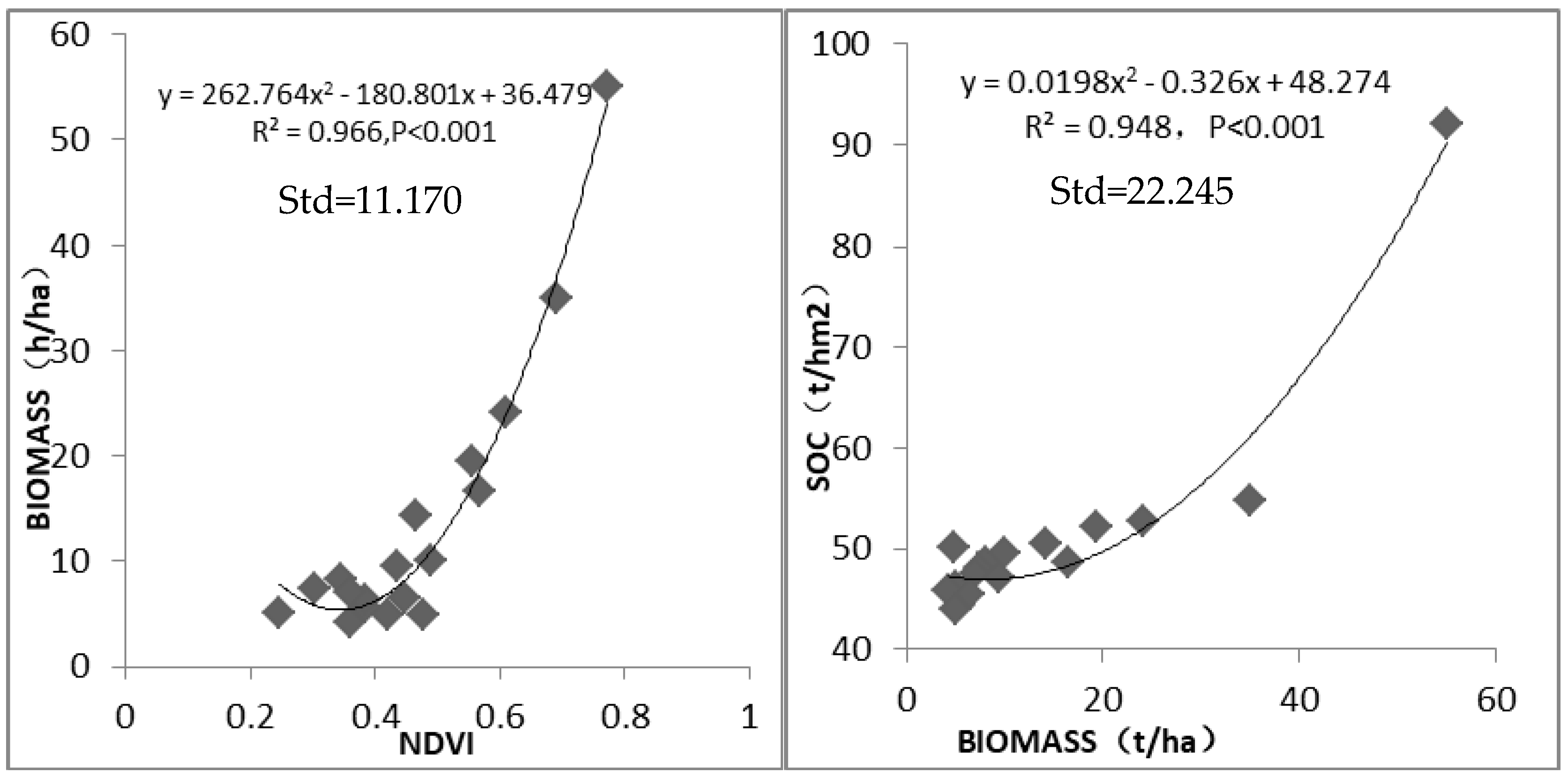
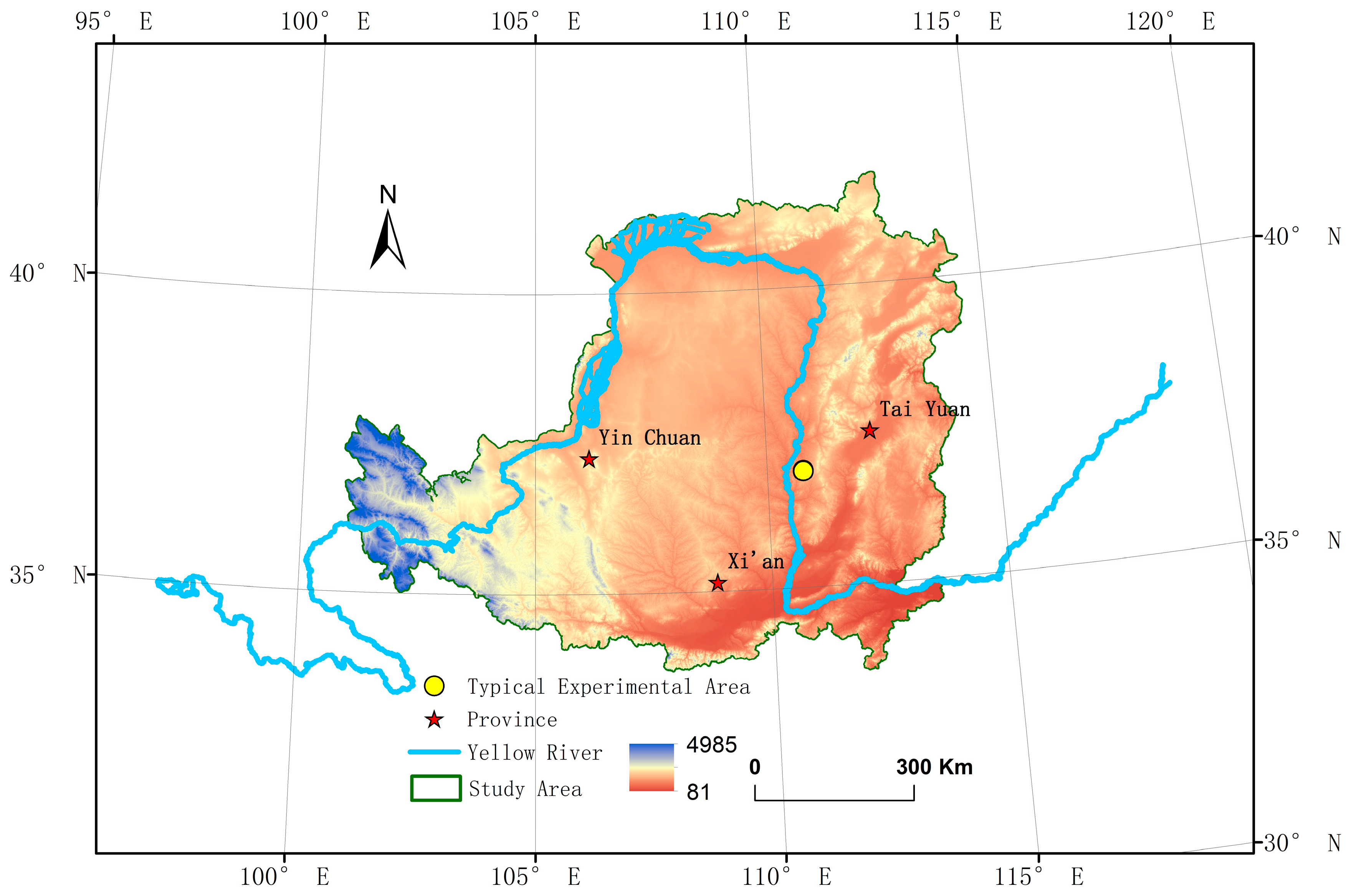
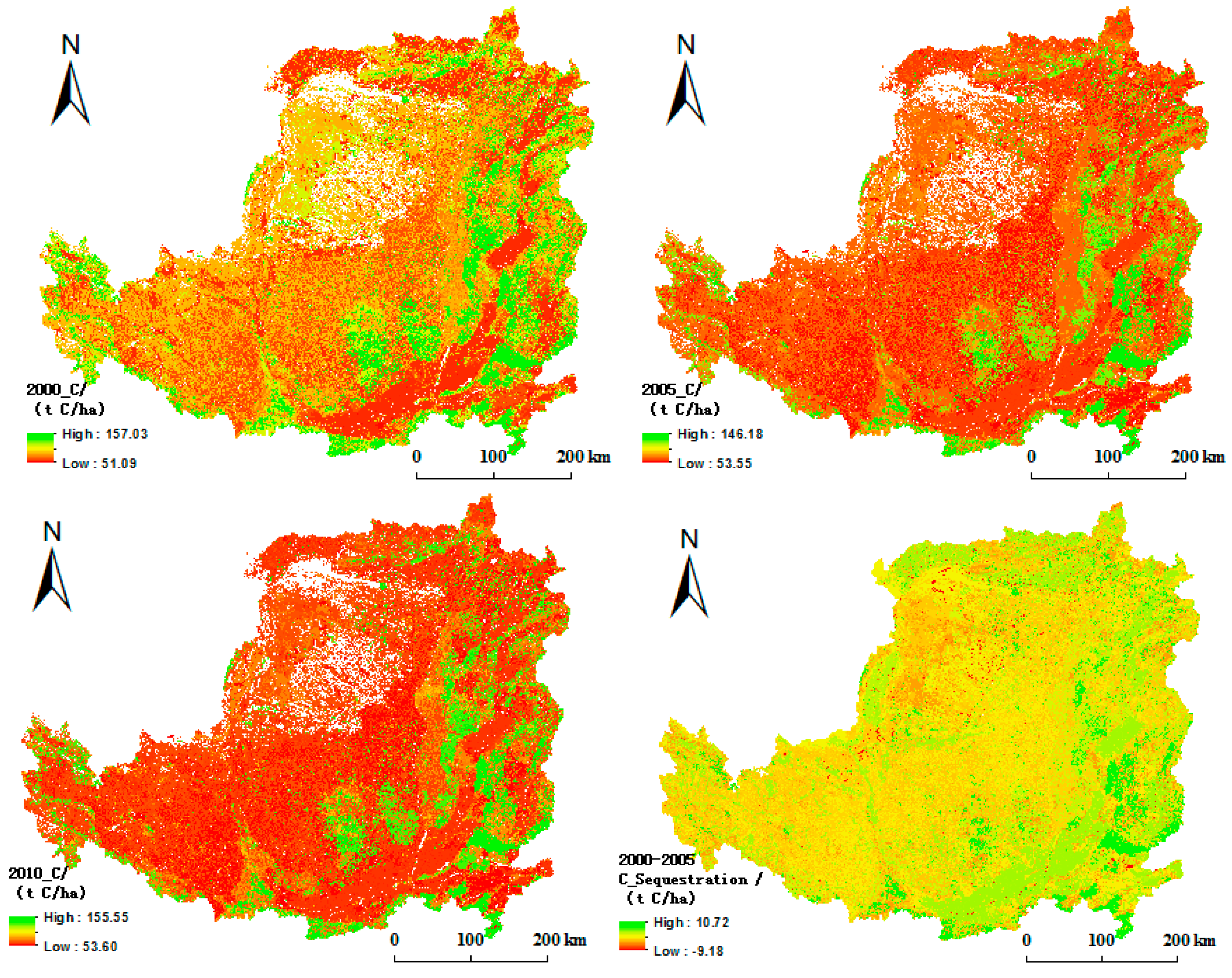
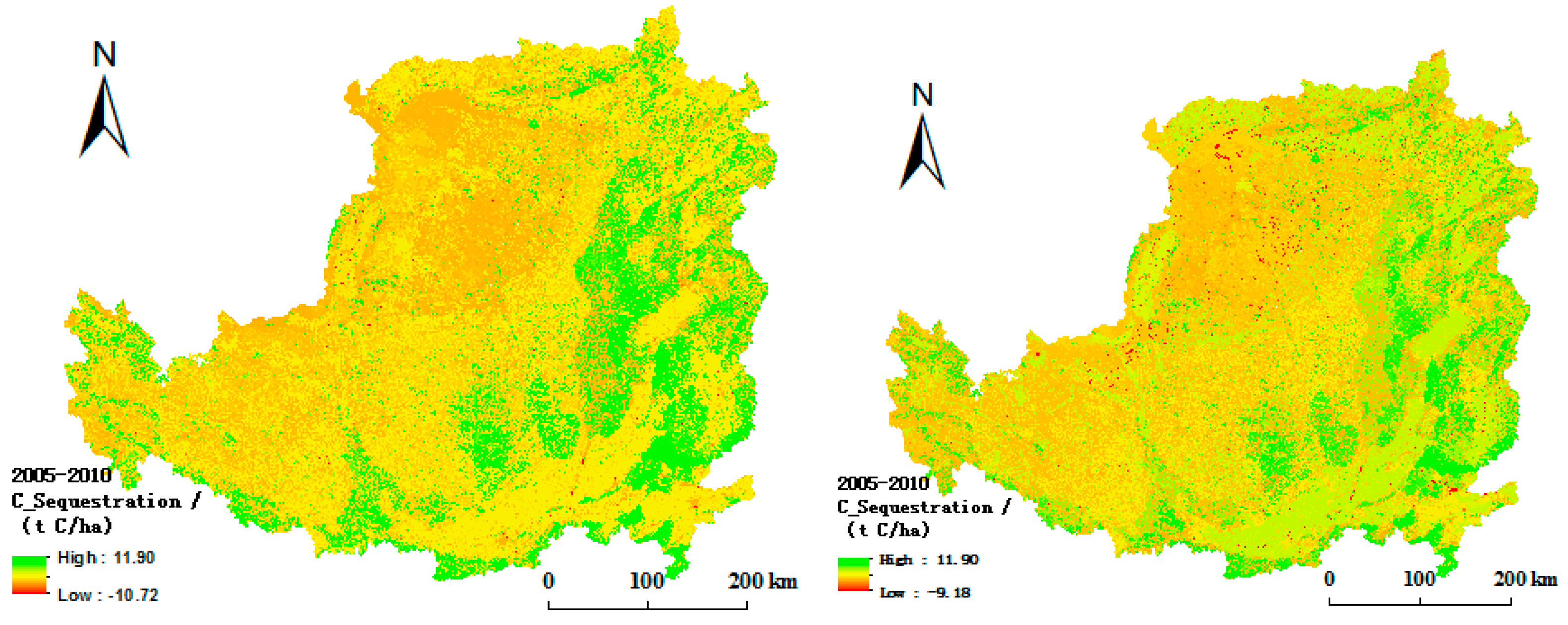
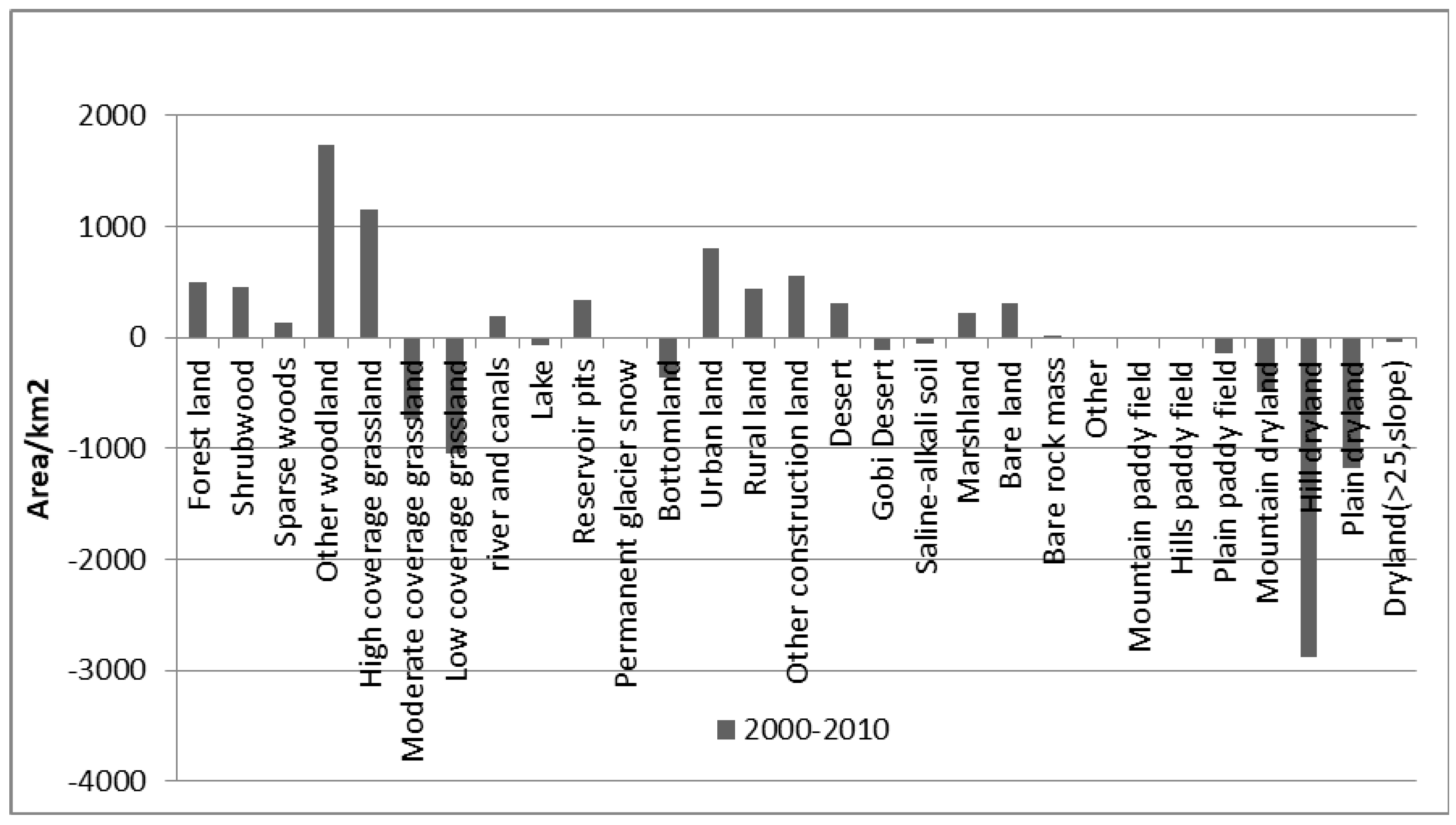

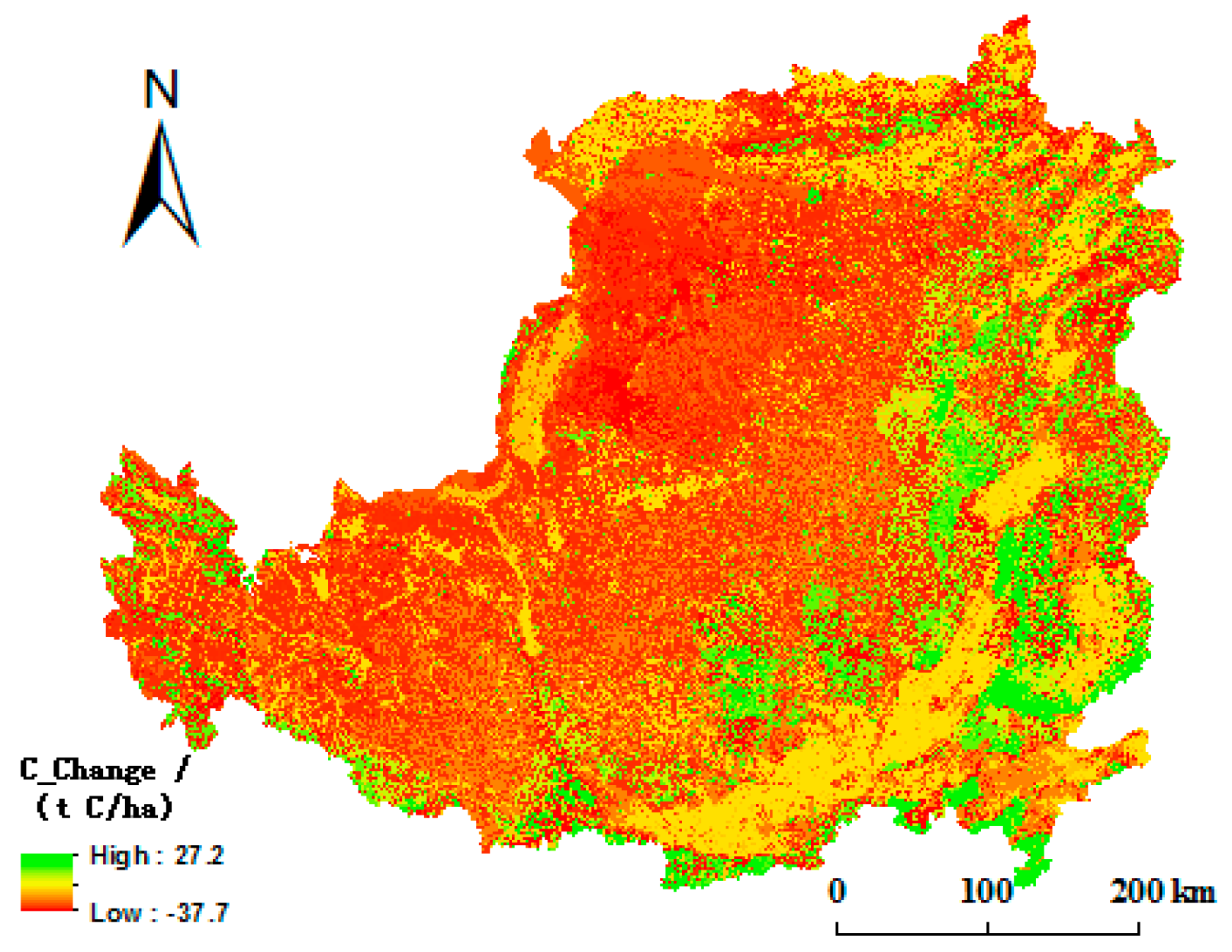
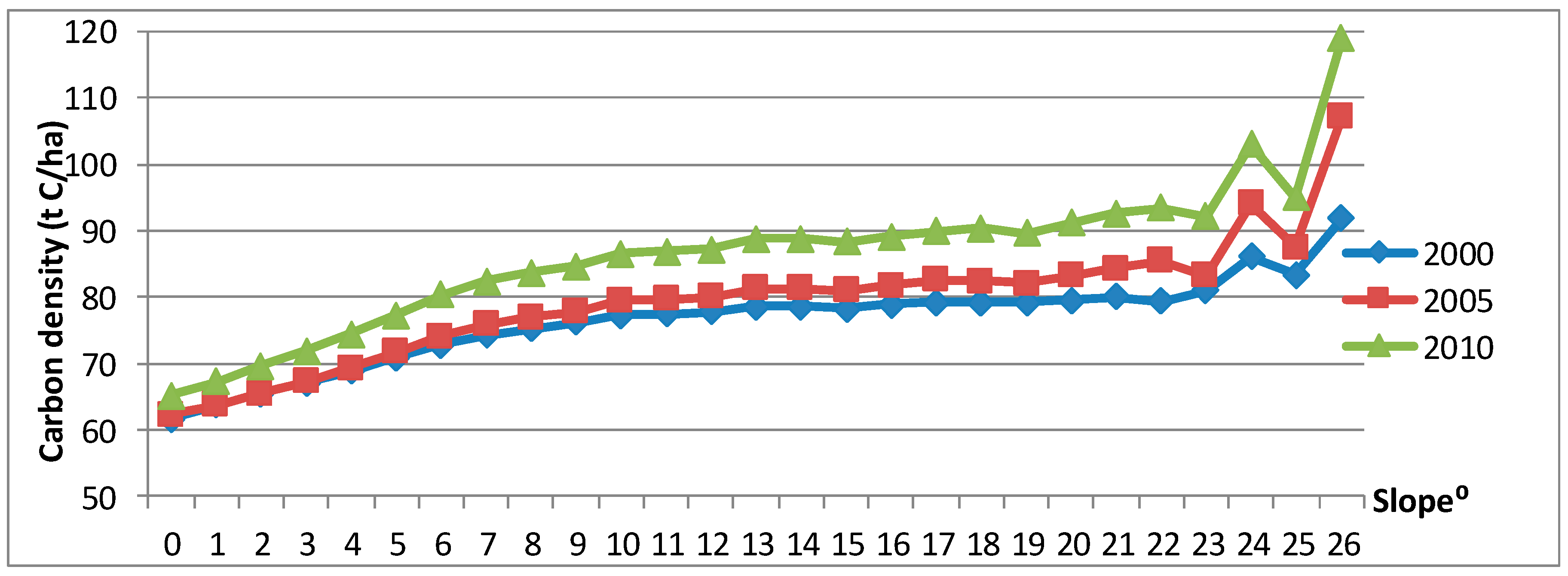
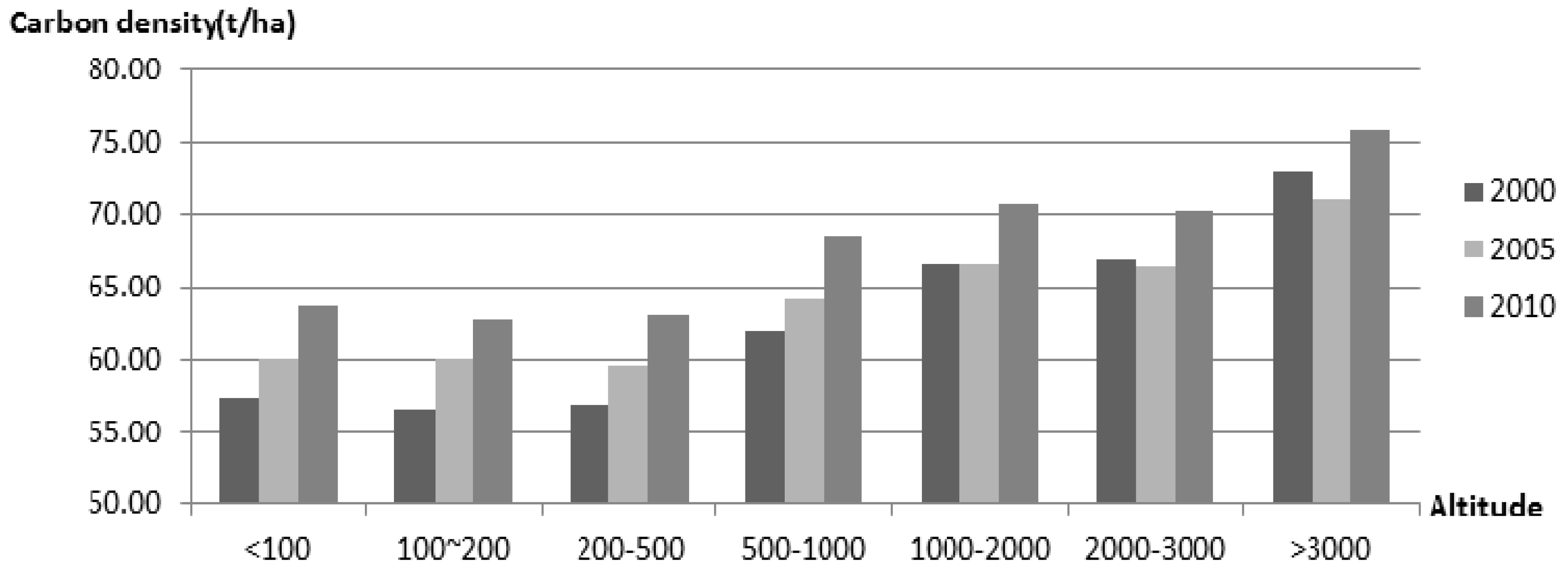
| Land Type | 2000/(t/ha) | 2005/(t/ha) | 2010/(t/ha) | 2010–2000/(t/ha) | 2005–2000/(t/ha) | 2010–2005/(t/ha) |
|---|---|---|---|---|---|---|
| Forest land | 91.79 | 107.17 | 118.99 | 15.38 | 11.83 | 27.2 |
| Shrubwood | 86.91 | 90.77 | 104.04 | 3.86 | 13.27 | 17.13 |
| Sparse woods | 73.68 | 71.66 | 81.26 | −2.02 | 9.6 | 7.58 |
| Other woodland | 58.79 | 56.73 | 60.18 | −2.06 | 3.45 | 1.39 |
| High-coverage grassland | 74.85 | 67.76 | 71.07 | −7.08 | 3.31 | −3.77 |
| Moderate-coverage grassland | 66.80 | 62.94 | 64.41 | −3.86 | 1.47 | −2.39 |
| Low-coverage grassland | 65.42 | 62.51 | 62.94 | −2.91 | 0.43 | −2.48 |
| Urban land | 51.38 | 53.55 | 53.60 | 2.17 | 0.06 | 2.23 |
| Rural land | 52.86 | 58.03 | 60.27 | 5.18 | 2.23 | 7.41 |
| Saline-alkali soil | 52.30 | 54.69 | 53.77 | 2.39 | −0.92 | 1.47 |
| Marshland | 51.09 | 54.48 | 55.56 | 3.39 | 1.08 | 4.47 |
| Mountain paddy field | 157.03 | 146.18 | 155.55 | −10.85 | 9.37 | −1.48 |
| Hills paddy field | 59.00 | 62.92 | 75.61 | 3.92 | 12.7 | 16.61 |
| Plain paddy field | 64.92 | 69.02 | 71.79 | 4.1 | 2.77 | 6.87 |
| Mountain dryland | 60.64 | 63.05 | 73.42 | 12.78 | 2.41 | 10.38 |
| Hill dryland | 55.53 | 54.91 | 58.13 | 2.60 | −0.62 | 3.22 |
| Plain dryland | 52.86 | 58.48 | 61.72 | 8.86 | 5.62 | 3.24 |
| Dryland (>25 slope) | 66.32 | 73.44 | 86.61 | 20.29 | 7.12 | 13.17 |
| Slope (°) | 2000 (t/ha) | 2005 (t/ha) | 2010 (t/ha) |
|---|---|---|---|
| 0 | 61.70 | 62.37 | 65.14 |
| 1 | 63.79 | 63.68 | 67.29 |
| 2 | 65.52 | 65.41 | 69.62 |
| 3 | 67.16 | 67.21 | 71.84 |
| 4 | 68.92 | 69.29 | 74.39 |
| 5 | 70.97 | 71.71 | 77.28 |
| 6 | 72.87 | 74.17 | 80.28 |
| 7 | 74.28 | 75.85 | 82.34 |
| 8 | 75.27 | 77.05 | 83.70 |
| 9 | 76.16 | 77.85 | 84.67 |
| 10 | 77.27 | 79.51 | 86.61 |
| 11 | 77.47 | 79.72 | 86.81 |
| 12 | 77.74 | 79.97 | 87.13 |
| 13 | 78.58 | 81.33 | 88.75 |
| 14 | 78.59 | 81.33 | 88.79 |
| 15 | 78.26 | 80.93 | 88.33 |
| 16 | 78.82 | 81.74 | 89.05 |
| 17 | 79.20 | 82.53 | 89.92 |
| 18 | 79.26 | 82.45 | 90.40 |
| 19 | 79.19 | 82.08 | 89.54 |
| 20 | 79.51 | 83.24 | 91.18 |
| 21 | 80.08 | 84.29 | 92.62 |
| 22 | 79.41 | 85.50 | 93.34 |
| 23 | 81.03 | 83.19 | 92.12 |
| 24 | 86.14 | 94.03 | 103.02 |
| 25 | 83.32 | 87.47 | 95.03 |
| 26 | 91.79 | 107.17 | 118.99 |
| Altitude (m) | 2000 (t/ha) | 2005 (t/ha) | 2010 (t/ha) | Average (t/ha) |
|---|---|---|---|---|
| <100 | 57.31 | 59.97 | 63.73 | 60.34 |
| 100~200 | 56.56 | 60.08 | 62.74 | 59.79 |
| 200–500 | 56.90 | 59.59 | 63.01 | 59.83 |
| 500–1000 | 62.02 | 64.17 | 68.57 | 64.92 |
| 1000–2000 | 66.53 | 66.61 | 70.68 | 67.94 |
| 2000–3000 | 66.94 | 66.41 | 70.21 | 67.85 |
| >3000 | 72.94 | 71.11 | 75.92 | 73.32 |
© 2018 by the authors. Licensee MDPI, Basel, Switzerland. This article is an open access article distributed under the terms and conditions of the Creative Commons Attribution (CC BY) license (http://creativecommons.org/licenses/by/4.0/).
Share and Cite
Liu, G.; Zhao, Z. Analysis of Carbon Storage and Its Contributing Factors—A Case Study in the Loess Plateau (China). Energies 2018, 11, 1596. https://doi.org/10.3390/en11061596
Liu G, Zhao Z. Analysis of Carbon Storage and Its Contributing Factors—A Case Study in the Loess Plateau (China). Energies. 2018; 11(6):1596. https://doi.org/10.3390/en11061596
Chicago/Turabian StyleLiu, Gaohuan, and Zhonghe Zhao. 2018. "Analysis of Carbon Storage and Its Contributing Factors—A Case Study in the Loess Plateau (China)" Energies 11, no. 6: 1596. https://doi.org/10.3390/en11061596
APA StyleLiu, G., & Zhao, Z. (2018). Analysis of Carbon Storage and Its Contributing Factors—A Case Study in the Loess Plateau (China). Energies, 11(6), 1596. https://doi.org/10.3390/en11061596





